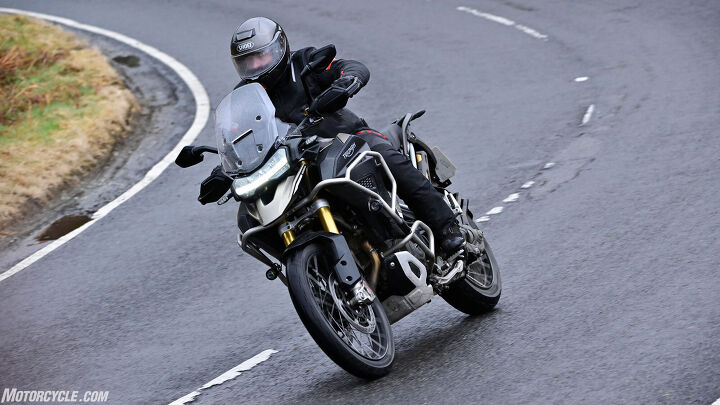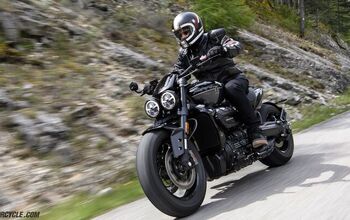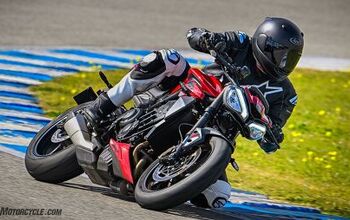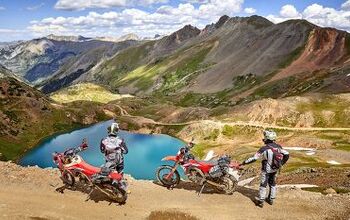2024 Triumph Tiger 1200 Explorer Review – First Ride

More spinning mass for the Tiger’s Triple
For the 2024 model year, the US will see only the Tiger 1200 Explorer models hitting dealership floors, while our friends up north will have the Pro models only. In 2025, the whole family will be getting back together in both countries. So, for now, we’ll focus on the Tiger 1200 Explorer models and the slight revisions that Triumph brought us to the beautiful Scottish countryside just outside of Glasgow, to test out.
2024 Triumph Tiger 1200 Explorer
The Tiger 1200 Explorers receive minor updates for the 2024 model year with a focus on engine internals.
Editor Score: 90.0%
Engine | 18.5/20 | Suspension | 14/15 | Transmission | 9/10 |
Brakes | 9.5/10 | Instruments | 4/5 | Ergonomics | 8.5/10 |
Appearance | 9/10 | Desirability | 9/10 | Value | 8.5/10 |
Highs
- Big Triples will always be fun
- Resolute in the face of Scottish weather
- Every touring comfort you could ask for
Sighs
- Still snatchy on/off throttle
- Prices continue to creep
- We’re pushing some serious weight in Rally Explorer trim
Little has changed overall for the Triumph Tiger 1200 since its major overhaul for the 2023 model year – and really, that’s not a bad thing. When we last tested the bike in March of 2022, Triumph had given its open-class ADV a ground-up redesign leaving nothing untouched. A combination of weight loss, increased power, and an overall massive upgrade in adventure performance elevated the Tiger 1200 from a long-toothed senior, to a serious contender in the open-class ADV segment. For 2024, the Explorer models get a few thoughtful tweaks with a focus on the “balancing strategy” and rotational inertia of the engine. Let’s get into it.
Read More: 2023 Triumph Tiger 1200 Review - First Ride
Bulking up
Light makes right, right? Well, not always. It’s interesting to listen to a manufacturer talk its way around the fact that it purposefully added weight to its engine. Particularly so, when it comes to Triumph who, for the past several years, has put an emphasis on making its engines as light as possible. From the modern classic range, to the tech-heavy ADVs, and all the sporty bikes in between, adding lightness to these modern mills has been the goal. Removing heft from engine components brings with it a plethora of benefits which obviously includes overall lower weight, but also lets the engine spin up freely to create an exhilarating sporting experience. That said, many bikes don’t spend their lifetime at high rpm, and here is where a little weight in just the right place can have a major impact on the riding experience.
Triumph have now added weight to both the crankshaft and the stator rotor in an effort to increase the “flywheel effect” of the crankshaft which, in theory, should help to deliver smoother torque at low speed and make the bike less likely to stall at low rpm – something particularly useful for off-road riding. Of course, Triumph didn’t just slap on a flywheel weight and call it good, the added mass was strategically developed and placed to make the most beneficial impact, requiring a change in production processes along the way.
The revised crankshaft is forged and twisted up to 180 degrees in order to allow Triumph to undercut the counterweights. In doing so, this allows the counterweights to be as efficient as possible with more weight located on the outer rim where it will give the most flywheel effect. In addition, the heavier stator rotor also adds spinning inertia which should help the big Triple at low rpm. With all the variables that a crankshaft affects, this is not a simple undertaking and requires a comprehensive effort from nearly every component in the engine. Thus, the balancing strategy and engine calibration all needed to be revised in order for this approach to deliver a better experience for the rider.
While most of the other changes for 2024, like the half-inch longer clutch lever, flatter redesigned rider seat, and damped handlebars are certainly aimed at making the rider more comfortable, really, the second biggest addition to these Explorers is going to be the inclusion of what Triumph calls Active Preload Reduction. While this new feature comes standard for 2024, the software can be retrofitted to any Tiger 1200 sharing the same semi-active Showa electronic shock. To initiate Hinckley’s version of adaptive ride height, the bike must be under 40 mph. From there, a long press of the home button will lower the seat up to 0.78 inches and will stay in the lower position until you manually raise it (using the same process), or crest 51 mph. Initially, that number seemed high, but this was a well-thought out decision by Triumph, who didn’t want to force motorcyclists bouncing around town to have to constantly be lowering the bike when coming to a stop.
Riding Tigers in the land of unicorns
Our experience of the Scottish countryside was much like Glasgow itself – a juxtaposition of old and new. Ahead of our ride, we were able to spend some time walking around town. Much like rocketing through the countryside on what would be akin spaceships not so long ago, there’s a stark contrast between old buildings set against ultra-modern architecture in the city. There is also always a cozy pub a few blocks away serving up warmth, not by electronically heated grips and seats, but by way of savory pies and peaty drams meant to warm your soul – and, more than likely, you’ll find an old man or two who's been soaking up the spirits long enough to become chatty. “I’ve always been fascinated with motion and quickness,” the old man said, his glossy eyes staring off into a distant memory while his snow white beard partially conceals the ruddy cheeks underneath.
We left Mar Hall, an 18th century Edwardian mansion Triumph chose as basecamp, and headed north under the overcast sky in light drizzle toward the Trossachs via a mix of alphabetized UK roads. It was a proper Scottish start to the day replete with bagpipes mixing with the sound of English Triples as we begat our adventure. With my seat and grips heated, waterproof layers donned, and pinlock inserted, er, wait… I forgot to install the Pinlock into my new Shoei Neotec 3… amateur. Oh, well. Who needs to be able to see with all of these rider aids! Off we went.
The Tiger 1200 Explorer is just as good as I remembered, and while I’m typically bummed when we don’t get to test adventure bikes off-road, there’s a sense of relief that also comes with the job not involving sliding, jumping, and/or generally going fast on loose surfaces on 575-pound motorcycles. Instead, we got to enjoy the Tiger Explorers in what might be a more realistic habitat for the big tourers.
As we wound our way through narrow country roads, we used all 148 hp and 96 lb-ft (at the crank) to make quick work of slow moving traffic with excellent feedback and composure from the Stylemas and semi-active suspension. Both brewed confidence as we made passes on the wet and dirty tarmac whether it be at full tilt or in corners (that we could see through, of course) while skirting our way north.
Despite the nice folks at Shoei installing the SRL3 Sena communicator, I found myself enamored with the sound of the 1160cc Triple. Winding the T-plane crank up and down with the intake howls accentuated by the quickshifter pop during aggressive throttle application, it’s nearly as pleasant as a good set of pipes. Combine that with a chassis that can handle the aggression while being utterly stable and what’s not to like?
The 34.5-inch seat height of the Rally Explorer was where I appreciated the Active Preload Reduction, but even then, with the added mental overload of cramming everything I needed to know about this bike into my jetlagged mind, riding left, and the inclement weather, it was hard to remember to activate the feature. We also didn’t spend much time bouncing around the city, where I think this feature would really shine on the Rally model. The most surprising aspect of the Rally Explorer though, was how much more confident the bike felt while cornering. It feels like there may be a profile issue with the Metzeler Tourance tires found on the GT model. Between the two, the Rally sliced up wet corners much more precisely and confidently than its supposedly more road-biased sibling. Triumph lead/chase riders agreed, having admitted the handling felt so off they assumed the tire was at low PSI (or bar in that part of the world). Perhaps a tire swap would alleviate the issue, but I can’t say for sure.
An issue that seems to persist despite the work on low rpm power delivery from the added inertia, is the on/off throttle snatchy-ness. It’s still there and doesn’t feel much different. Once the revs start to climb, the machines are as smooth as ever, but the abruptness around town is still annoying and seems to likely stem from the driveline. With how excellent Triumph has managed its engines to this point, I’m doubtful the problem is fueling as it seems to only be a problem on these shaft-driven models. If I were smitten with the Tiger 1200 as a whole, it’s not enough for me to discount it, but it is there.
So here is where I find myself asking, if a new full price 2024 model was sitting next to a full-price 2023 model, which would I choose? There’s a $700 price increase for 2024, and if that was all it cost me to get the newest model with these changes, yes, I’d opt for the 2024. The reality is, if there are 2023 models sitting around, they’re likely going to be discounted. Without riding the two machines back-to-back, I can’t suggest to our readers that the 2024 model is night and day different from the previous model year, so opting for a ‘23 could net you a smoking deal on a pretty stellar touring machine. Of course, if you don’t find yourself needing the extra 2.6 gallons of fuel, heated grips and seats, TPMS, and rear-facing radar, you could always hold out for 2025 and get the Pro model which will have the same updates.
In Gear

- Helmet: Shoei Neotec 3
- Jacket: REV’IT! Tornado 4
- Pants: REV’IT! Tornado 4
- Gloves: REV’IT! Sand 4 H2O
- Boots: REV’IT! Discovery GTX
Specifications | 2024 Triumph Tiger 1200 Rally Explorer | 2024 Triumph Tiger 1200 GT Explorer |
|---|---|---|
Price | From $24,895 | From $23,795 |
Engine Type | Liquid-cooled, 12 valve, DOHC, inline 3-cylinder | |
Displacement | 1160 cc | |
Bore x Stroke | 90 mm x 60.7 mm | |
Compression | 13.2:1 | |
Max Power EC | 147 hp at 9,000 rpm (claimed) | |
Max Torque EC | 95 lb-ft. at 7,000 rpm (claimed) | |
Fueling | Multipoint sequential electronic fuel injection with electronic throttle control | |
Exhaust | Stainless steel 3 into 1 header system with underslung primary silencer and side mounted secondary silencer | |
Final Drive | Shaft drive | |
Clutch | Hydraulic, wet, multi-plate, slip and assist | |
Gearbox | 6-speed constant mesh | |
Frame | Tubular steel frame, with forged aluminum outriggers. Fabricated, bolt-on aluminum rear subframe. | |
Swingarm | Twin sided "Tri-Link" aluminum swingarm with twin aluminum torque arms. | |
Front Wheel | Spoked (Tubeless). 21 x 2.15 inches | Cast aluminum, 19 x 3.0 inches |
Rear Wheel | Spoked (Tubeless). 18 x 4.25 inches | Cast aluminum, 18 x 4.25 inches |
Front Tire | Metzeler Karoo Street, 90/90-21 (M/C 54V TL) | Metzeler Tourance, 120/70R19 (M/C 60V TL) |
Rear Tire | Metzeler Karoo Street, 150/70R18 (M/C 70V TL) | Metzeler Tourance, 150/70R18 (M/C 70V TL) |
Front Suspension | Showa 49mm, semi-active damping USD forks. 8.66 inches of travel. | Showa 49mm, semi-active damping USD forks. 7.87 inches of travel. |
Rear Suspension | Showa semi-active damping monoshock, with automatic electronic preload adjustment and New Active Preload Reduction feature. Depending on the combined weight of rider, pillion and luggage, this feature could lower the riding height by up to 0.78in when the motorcycle comes to a standstill, offering greater ease and confidence. 8.66 inches of travel. | Showa semi-active damping monoshock, with automatic electronic preload adjustment and New Active Preload Reduction feature. Depending on the combined weight of rider, pillion and luggage, this feature could lower the riding height by up to 0.78in when the motorcycle comes to a standstill, offering greater ease and confidence. 7.87 inches of travel. |
Front Brakes | Brembo M4.30 Stylema monoblock radial calipers, OC-ABS, twin 320mm floating discs. Magura HC1 span adjustable radial master cylinder with separate reservoir. | |
Rear Brakes | Brembo single piston caliper, OC-ABS, single 282mm disc. Rear master cylinder with remote reservoir. | |
Instrument Display and Functions | Full-colour 7” TFT instrument pack with My Triumph Connectivity System | |
Width Handlebars | Handlebars 33.42 inches, handguards 38.66 inches | Handlebars 33.4 inches, handguards 38.7 inches |
Height Without Mirror | Low screen 58.5 inches, high screen 60.9 inches | Low screen 56.5 inches, high screen 58.9 inches |
Seat Height | Adjustable 34.4/35.2 inches | Adjustable 33.5/34.5 inches |
Wheelbase | 61.4 inches | |
Rake / Trail | 23.7° / 4.72 inches | 24.0° / 4.72 inches |
Tank Capacity | 7.9 gallons | |
Wet Weight | 578 pounds (claimed) | 564 pounds (claimed) |
Service Interval | 10,000 miles (16,000 km) /12 months, whichever comes first | |
We are committed to finding, researching, and recommending the best products. We earn commissions from purchases you make using the retail links in our product reviews. Learn more about how this works.
Become a Motorcycle.com insider. Get the latest motorcycle news first by subscribing to our newsletter here.

Ryan’s time in the motorcycle industry has revolved around sales and marketing prior to landing a gig at Motorcycle.com. An avid motorcyclist, interested in all shapes, sizes, and colors of motorized two-wheeled vehicles, Ryan brings a young, passionate enthusiasm to the digital pages of MO.
More by Ryan Adams














































Comments
Join the conversation
I owned a 2014, so buzzy that my hands would go numb, tried everything to fix it, no fix. Twitchy throttle also, used camera lens lube to fix that. Tested a 2023, same issues, would love to see this gone in the '24.
Please explain the auto-play videos. Why do you hate your site visitors so much?
Nice writeup.
Too bad that it is impossible to put a "center" main bearing on an inline triple.
For the mechanical pundits, a bore/stroke differential of 30mm is way out there into space, but don't tell NASA.
Rick Politi(Burlington, Vermont)